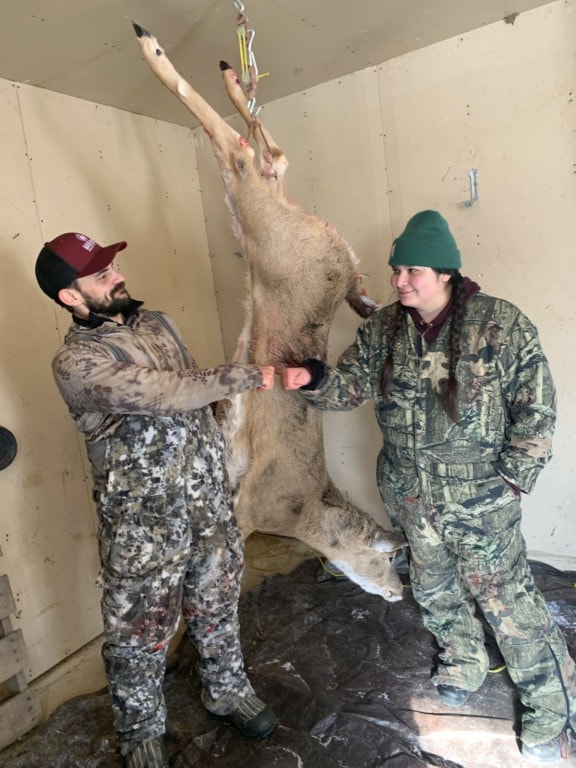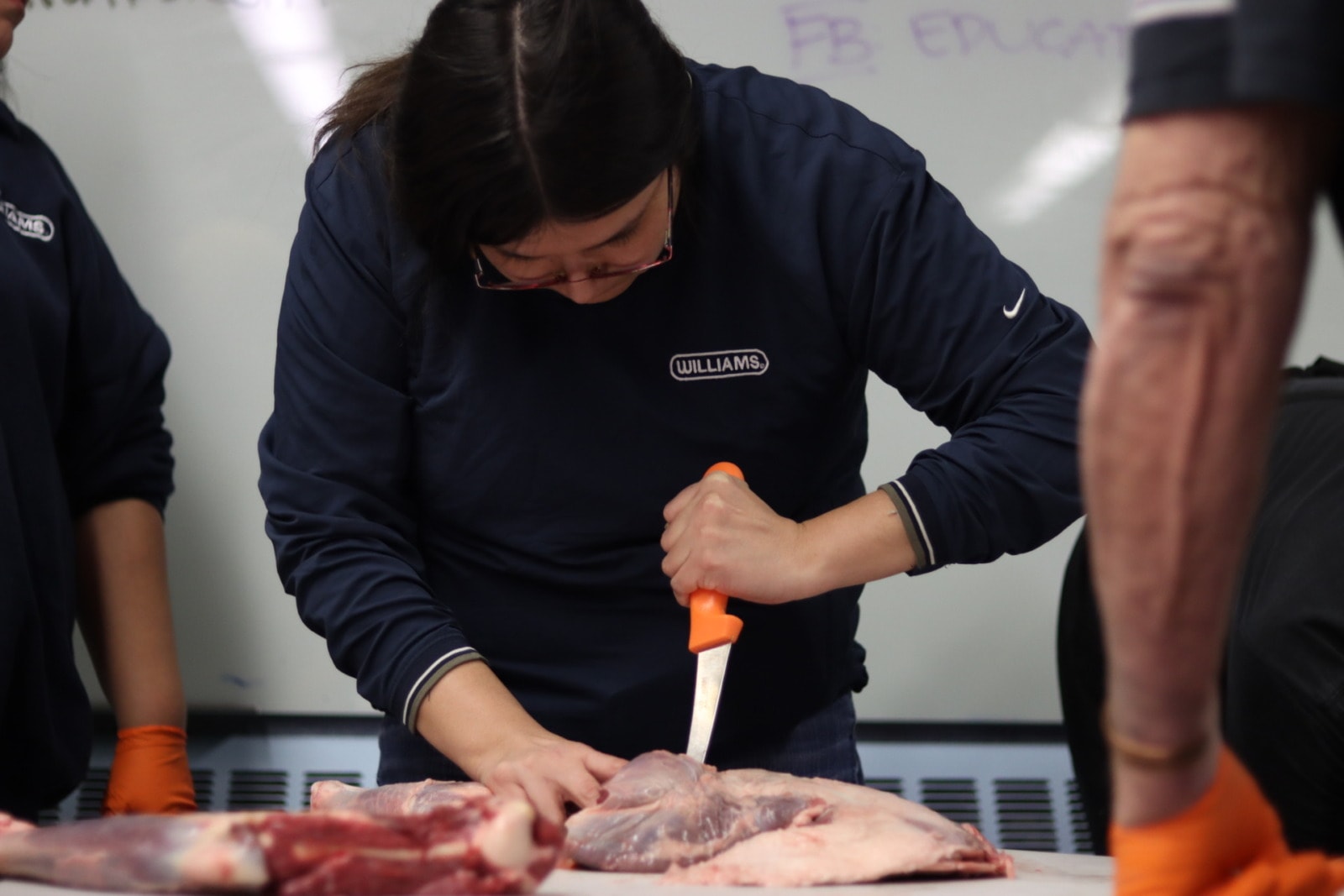Deer Hunt and Workshop Bring New Skills to Native Tribal Members Members of Indigenous Nations in Kansas Join Hunter’s Safety, a Guided Hunt and Other Events
Published January 31st, 2024 at 7:15 AM
Above image credit: Lee Meisel takes a deer from quarters into butcher cuts at a workshop in Lawrence. (Cami Koons | Flatland)LAWRENCE, Kansas — Shannon Piper’s day started in the dark, trudging through snow and trying to stay warm in sub-zero temperatures.
“As soon as the light came around, we saw deer within like five minutes,” Piper said.
From a deer blind she had set up with her mentor, Stephen Baca, Piper waited.
She saw deer a couple of times but didn’t use her crossbow — she only wanted to take a shot she knew would lead to a quick and ethical death.
Finally, a few crossed the field, and she took her shot.
“I thought I missed it at first,” Piper said.
Piper and Baca got up and found the arrow, frozen to the ground with blood from the artery it had severed. About 30 yards further, they found the deer. Piper had her first bag.
“I was pretty excited,” she said while eagerly recounting the adventure.
Piper, a member of the Navajo Nation, was one of six new hunters gathered in a field office on the northwest side of Clinton Lake. Several months ago, the group went through a hunter’s safety class specifically for members of Indigenous groups who live in Kansas.
The following week, the same group, and other members of the public, attended workshops about deer harvesting, butchering, cooking and tanning hides.

Connection and Partnership
Amy Bousman, the Kansas City District Education Specialist for the Kansas Department of Wildlife and Parks, said this was the first BIPOC (Black, Indigenous, People of Color) specific programming put on by the department.
“It’s a really good opportunity for … BIPOC folks to see that within these state agencies, they have anti-racist allies available,” Bousman said.
Bousman organized Indigenous teachers for the hunter’s safety course who could also talk about conservation practices and traditional ecological knowledge.
Throughout the course, Bousman said the group had discussions around ethics and the ancestral connection to wild land.
These conversations attracted Luke Walker, who joined the class in part because of his capstone paper for his American Indian Studies degree from Haskell Indian Nations University. Walker wrote about the kinship between wildlife and place.
“(The capstone) got me thinking about hunting and that it was time to learn it,” Walker said.
“Food came from life, and that’s something we tend to forget when we’re getting it from the grocery store.”
Walker, who is a member of the Seminole Nation, saw several groups of deer on the snowy hunt, but none close enough to shoot. While he wanted to get a deer, Walker said part of the experience for him was just being out in the wild.
“It’s a long time coming to finally go hunting and it’s something I want to continue doing,” Walker said.
More on Wild Food
Hunting, fishing and trapping licenses are free to Kansas residents who have tribal membership and have passed a hunter education course.
Bousman wanted to not only offer the classroom instruction required for the license, but to give folks the field knowledge to follow through with the process.
Six people from the course chose to continue with a mentored bow hunt, which Bousman organized in collaboration with volunteers and the Corps of Engineers at Clinton Lake who opened a late season hunting area, usually reserved for veteran or youth-led hunts.

At the hunt on Saturday, each new hunter had an assigned mentor. These volunteer mentors also brought their own or borrowed crossbows for their mentees to use.
“It blows my heart open, it’s phenomenal,” Bousman said of the community and volunteer support for the program.
Mentors taught the hunters how to shoot their crossbows, where to set their blinds, what to bring on a hunt, how to look for tracks and to be patient and persistent.
“There’s a lot of boundaries that are tough to break through on your own,” said Luke DeCicco, one of the volunteer mentors. “It’s just good to go out with somebody who knows what’s going on.”
Bousman likes to create “field-to-fork programming,” meaning the educational opportunities didn’t stop after the mentored hunt, where Piper was the only one to bag a deer.
The following day, the group and interested members of the public were invited to a processing workshop, where they learned to skin, quarter and test the deer for Chronic Wasting Disease.
And throughout last week, Piper’s deer and a donated deer were used for workshops on cooking, hide processing and butchering. All of these were led by Indigenous experts, free to the public and heavily attended.
Making the Most of the Hunt
Lee Meisel is the owner of Leeway Butcher in Lawrence and a member of the Standing Rock Sioux Tribe of North Dakota. Last week he led the final workshop of the Indigenous deer hunt series Bousman organized.
Piper watched eagerly as Meisel demonstrated the proper butcher techniques on a hind quarter of her deer. With each cut, he explained the physiology of the part, the name of the cut and how it would be best cooked.
The classroom at Haskell was crowded with about 40 people, both Native and non-Native folks eager to learn from a professional and ask him questions.
“There definitely appears to be quite a bit of interest in people learning these skills … and making more informed food decisions,” Meisel said following the event.
Recently, Meisel shifted his business and transformed the dine-in space of his restaurant “Leeway Franks” to host butchering and culinary classes. He held his first class, a whole-hog butchering workshop, in mid-January.
“The biggest thing lacking in our industry is more of us,” Meisel said. “I don’t want these skills to get automated or die out.”
The deer butchering workshop fit well with his passion for teaching, and he always likes the opportunity to visit his alma mater and show other Indigenous transplants that, “somebody from a reservation in North Dakota can make a life in Lawrence.”
According to 2021 enrollment data, Haskell has students from 125 different tribal nations. Many come from out of state to attend the university.
“We are all so many different languages, cultures … and Haskell brings it all together,” Meisel said.

Following Meisel’s demonstration, Piper and other attendees donned gloves and sharp carving knives to finish breaking down the deer.
Others mingled about the room and chatted with one another. For many, Piper included, the workshops were a good place to meet like-minded people and build a hunting community.
Throughout the week, Bousman garnered interest in future iterations of Native deer hunt education. She plans to resume the programming in September, in time for another class of new hunters to take on deer season.
More field-to-fork style programming can be found on the Kansas Wildlife and Parks’ Education and Outreach page.
Piper sliced carefully to butterfly some of her cuts, following Meisel’s instruction, and created beautiful, deep red medallions of meat.
Later, she wrapped her cuts of venison in white butcher paper and placed the parcels into a cooler to take home.
“I’ve learned so much,” she said. “On the field but also in the classes this week as well.”
Cami Koons covers rural affairs for Kansas City PBS in cooperation with Report for America. The work of our Report for America corps members is made possible, in part, through the generous support of the Ewing Marion Kauffman Foundation.


